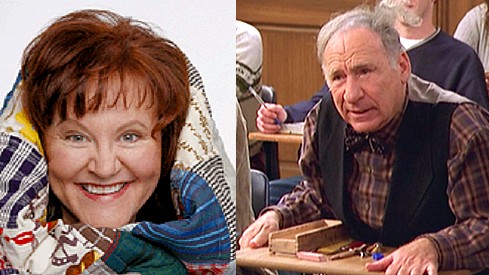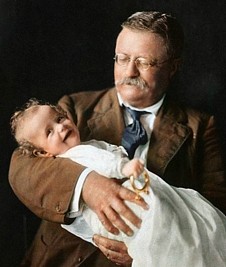JUNE
29, 2022 ![]() THE ARGUMENT IN THE ATRIUM
THE ARGUMENT IN THE ATRIUM
Parts of the gospels of Matthew and Luke are nearly identical to each other. (Is this surprising? They're telling the same story.)
“To what shall I compare the kingdom of God? It is like yeast which a woman took and mixed with three measures of flour till it was all leavened.” Luke 13:20-21
“The kingdom of Heaven is like yeast, which a woman took and mixed with three measures of flour till it was all leavened.” Matthew 13:33
|
Bible scholars note how the wording of some passages is almost the same. The implication is that both Matthew and Luke must have copied these parts from earlier books. |
|
|
Certain passages apparently came from the gospel of Mark, but other parts (like the parable of the leaven) must have been derived from a different common source that consisted of sayings of Jesus. That source has not been discovered. Because the word for “source” in German is Quelle, this hypothetical sayings collection is usually called Q. |
|
However, the Apostle Paul had read neither Mark nor Q nor Matthew nor Luke. I've imagined a first-century incident in which Q Visits a Corinthian.
JUNE
27, 2012 ![]() A ROOM OF ONE'S OWN
A ROOM OF ONE'S OWN
As an only child, I had my own bedroom. As an introvert, this suited me just fine.
I didn’t usually have that benefit of privacy away from home. When I traveled with my parents, the three of us would share a motel room. In college, I had to share my freshman dorm space with a roommate (although for the remaining three years I made sure to sign up for a single room). Later, when I traveled with a TV production crew, our employer would usually save money at the hotel by pairing us up.
This changed when, at the age of 40, I went on the road to cover Pittsburgh Pirates games. There were four of us on the KDKA-TV traveling crew, the hotels were first class, and each of us was assigned his own separate room! I asked myself what I had done to deserve this unprecedented luxury.
Although I never really had a serious girlfriend, I idly imagined what married life would be like for an introvert like me. I presumed I wouldn’t mind sharing my home with a woman who was my best friend. On the other hand, I wouldn’t want our idyllic partnership to be disrupted by a bunch of noisy hyperactive midgets running around and demanding all our attention. In other words, I didn’t want children infesting my castle. My hypothetical wife, of course, would feel the same way, or she wouldn’t have married me.
Despite the fact there would be only two of us, our ideal home would have three bedrooms. One would be exclusively my wife’s, another would be exclusively mine, and the third would be the “guest room.”

Each of us would agree never to enter the other’s private chamber. Those rooms could possibly contain old love letters or other items which we preferred our partner not to know about. If I withdrew into my sanctuary and closed the door, she wouldn’t be allowed to resent it nor to feel neglected or unloved, and vice versa. We would understand and respect each other’s needs to be alone, to think our own thoughts, or to get up in the middle of the night without owing anyone an explanation.
And when we wanted to spend an intimate night together, we would rendezvous in the guest room.
|
2020
UPDATE: This arrangement isn't totally unheard of.
According to a survey, more than a third of Americans sometimes sleep
in another room from their partner. While a "sleep
divorce" might sound alarming, experts say it can actually help
people feel more well-rested and contribute to stronger relationships.
|
JUNE
23, 2022 ![]() IMMUNIZATION PROGRESS REPORT
IMMUNIZATION PROGRESS REPORT
David Leonhardt of the New York Times noted this month that “the share of white Americans who have received a Covid vaccine shot has barely budged since last summer.
|
“The
main culprit is politics. Only about 60 percent of |
|
|
|
|
“In heavily conservative, white communities, leaders have not done as good a job explaining the vaccine's benefits — and Covid's risks — as leaders in Black and Latino communities.” |
|
|
|
White conservative Christians tend to trust in God to somehow protect them from the virus. They're convinced they need faith, not a shot. Many Black pastors, on the other hand, preach that God provided advancements in science and medicine for the benefit of humanity. “Ignorance enslaves us. My people perish due to a lack of knowledge, the Bible says.” |
Leonhardt concludes, “Many conservative media figures, politicians, clergy members and others have amplified false or misleading information about the vaccines. Millions of Americans, in turn, have chosen not to receive a lifesaving shot. Some have paid with their lives.”
JUNE
20, 2022 ![]() MY BLUSHING ROSIE
MY BLUSHING ROSIE
Comedy legend Mel Brooks occasionally appeared on Mad About You as “Uncle Phil,” who had dropped out of high school 63 years before.
|
During one episode, he sang a 99-year-old love song to one of my grad-school classmates. I tried to explain in this month's 100 Moons article. |
|
|
|
Today we celebrate Father’s Day. However, fatherlessness is becoming the norm. According to the National Center for Health Statistics, the percentage of babies born to unmarried women has been increasing every decade. It surpassed 40% in 2009. We can project that nine years from now, half of all American newborns will be bastards! |
|
|
2022 CORRECTION: That projection has not been realized. Above, I've added a green line to my ten-year-old graph to show that although the percentage of births to unmarried women did peak at 41.0% in 2009, it now appears to have plateaued. (There was an earlier plateau in the 1970s, though the level was only a third of the present rate.) For 2020, the most recent year for which statistics are available, the percentage was 40.5%. |
Why should we be concerned about this? George Will writes that “social ... pathologies, related to a constantly renewed cohort of adolescent males without fathers at home, include disorderly neighborhoods, schools that cannot teach, mass incarceration, and the intergenerational transmission of poverty. We do not know how to address this with government policies, even though the nation has worried about it for almost 50 years. In 1965, Daniel Patrick Moynihan, then in President Lyndon Johnson’s administration, published his report on the black family’s ‘crisis,’ which was that 24 percent of black children were then born to unmarried women. Today, 73 percent are.”
Charles Murray notes “the well-established fact that children fare far better in two-parent families — on virtually every indicator, from emotional development to the likelihood of being employed as adults — than they do in divorced families, and children in divorced families do better than children of never-married women. And this remains true even after controlling for economics and race.”
|
|
A related problem: children being born to teenage mothers, many of whom are not yet married. This map shows the number of births per 1,000 girls aged 15 to 19, according to the Centers for Disease Control, which reports “the U.S. teen birth rate remains one of the highest among other industrialized countries.” Rates are the highest in the Bible Belt, suggesting that religiously-approved chastity pledges might not be the most reliable method of teenage birth control. |
JUNE
16, 2012 ![]() ANDNOWTHESEMESSAGES
ANDNOWTHESEMESSAGES
Sometimes while driving in my car I’ll be listening to a baseball game on the radio, and I’ll momentarily be distracted by my responsibilities as a motorist, and when I turn my attention back to the baseball broadcast I realize that they’re in a commercial break. “Hmm,” I’ll say to myself, “I guess the inning must have ended while I was turning onto that ramp. The announcers must not have made a big deal about how the third out happened.”
I actually was paying attention last night during the Pittsburgh at Cleveland game. The Pirates, trailing 1-0, were batting in the top of the fourth inning. There had been two walks and two strikeouts sandwiched around a single, and the bases were loaded. The Pirates had a rare offensive threat going!
Jose Tabata came to the plate with two outs. Pirates play-by-play man Greg Brown was calling the action. Analyst John Wehner was dissecting every pitch, describing what the pitcher was trying to do and what the batter was trying to do. Tabata took a strike. He fouled off the next offering. This was a crucial point in the ballgame. And then Greg called the next pitch: “Swing and a miss. After 3½ innings: Indians one, Pirates nothing.” And we were in commercial.
Greg’s rueful tone implied, “My goodness, that was rather disappointing for us to waste such a golden opportunity, wouldn’t you agree?” But he didn’t have time to say it. And John had no time to explain what had happened on the final pitch. The radio announcers had to get to the break immediately so all the ads could run before action resumed.
At least on television, we schedule slightly less commercial time so that we can replay Tabata’s swing while we’re “rolling out to break.”
JUNE
12, 2022 ![]() VINGT-QUATRE HEURES
VINGT-QUATRE HEURES
I watched the 24 Hours of Le Mans endurance race yesterday and today. Well, not the whole 24 hours, of course; just bits here and there. I wasn't familiar with the drivers or teams, except for a few manufacturers like Porsche and Corvette. But it was mesmerizing to watch the cars make their way around the eight-mile circuit, come in for pit stops, and occasionally suffer mishaps.
Some mishaps resulted in pieces of the cars violently being torn off. But not all were like that. You know how, when a storm brings down a live electrical wire, you're warned not to touch it lest you be electrocuted? You know how, when your computer locks up, you have to turn it off and on and wait for it to reboot?
|
|
At one point the leader of the race (and the eventual second-place finisher), the #7 Toyota, suddenly pulled over to the side and parked. Eventually the driver Jose Maria Lopez got rolling again, came into the pits, and stopped. But his crew just stood around the car. They weren't allowed to touch it because it was “unsafe.” Lopez had to keep punching buttons — “wait five seconds, and then...” — until all the electrics and electronics were working again. Weird. |
It's been almost 35 years since I worked the telecast of one of these endurance races. It was the 12 Hours of Sebring, in Florida. As nearly as I can recall, it went like this:
The start and finish and other portions of the 12 hours aired on ESPN, while other segments aired on their new second channel ESPN2. (Both channels had other events to cover. A few portions of the race weren't televised live at all.) Two ESPN-owned remote production trailers were on site, a 40-foot one for the main production and a 27-foot one for a “B Unit,” plus a tent for engineering and catering.
|
In those days, ESPN2 differentiated itself from the mother ship by using a completely different lower-case font style. Here's a football example. My coordinator and I were assigned to be on air during the ESPN2 hours. Otherwise, we sat in the B Unit and kept track of driver changes and such. Then when it was almost time to switch from ESPN coverage to ESPN2, we grabbed our discs and stood in wait at the bottom of the stairs of the larger trailer. At the station break, we executed a hurried “driver change.” We replaced the ESPN graphics guys at the second bench, inserted our discs, and restarted the graphics machine. |
|
Once we were up and operating, the first task was to get the 12-hour countdown clock running on one of our channels. A couple of minutes after ESPN2 hit the air, our clock was ready to be inserted into the picture. (If it was inaccurate by a few seconds, who would notice?) Then on the other channel we busied ourselves with other graphics, chiefly leader boards.
In those days, all graphics had to be typed using a keyboard. Nowadays most come directly from computers fed by the track's timing and scoring network, so it's entirely different — and much more up-to-date and informative.
I still remember how difficult it was after the sun set at Sebring to tell one car from another. A few portions of the circuit were lighted, but most were not.
|
|
The typical auto-racing shot shows a few cars speeding toward the camera. That doesn't work very well when we can see nothing but headlights. Which pair of white blurs belongs to which car? Somehow our announcers seemed to know, but I couldn't tell. Last night, the Le Mans crew used such useless white-out angles rather sparingly, sort of like “beauty shots” akin to the full moon or the Ferris wheel. |
They had alternatives. They could follow the competition from a large selection of on-board cameras inside various cars. Also, for side views of the action, each present-day car displays an illuminated number near the door. The leaders even display their position in lights. Better!
JUNE
9, 2012 ![]() INFORM THE VIEWERS!
INFORM THE VIEWERS!
I recall one spring evening back in the 1950s, when televised variety shows were broadcast live. My parents and I were watching Perry Como’s 39th and last “Kraft Music Hall” of the season. For the next 13 weeks, a summer replacement series was going to fill his time slot. So at the end of the final musical number, Perry said goodbye, and the Ray Charles Singers waved goodbye (no, not that Ray Charles), and a huge Broadway-type sign descended. In lights, it said, SEE YOU IN SEPTEMBER!
Nowadays, however, most TV series don’t spell it out so clearly. From Rob Owen’s “TV Q&A” column yesterday:
Q: My question is what happened to “NCIS”? Two weeks ago it blew up with McGee trying to get Abby out and Ducky walking along a beach when he heard about “NCIS” and he collapsed with the tide coming in. The next two weeks, everything was back to normal.
- Marillyn Swanson, 84, Apple Valley, Minn.
Rob: The television season, as it always has, runs from September to May. The episode with Ducky collapsing was the season finale. The episodes that followed were typical summer reruns. The resolution to the Ducky collapse cliffhanger will come in September.
My question is, how are we supposed to know this? If we don’t read columns like Rob’s or listings like TV Guide, we may well be unaware that we’re watching a season finale. For viewers like Marillyn, every cliffhanger should be followed immediately by a special promo.
What will happen? Will Abby escape?? Will Ducky survive??? We’ll have to wait until September to find out! “NCIS” will return with new episodes in the fall. Until then, for the next several weeks, join us here at this same time as we repeat some of your favorite episodes from this season. Thanks for being a loyal viewer of “NCIS”!
JUNE
7, 2022 ![]() PRIME SLEEPING TIME
PRIME SLEEPING TIME
Look, Mommy, it's almost dark out.
Yes, it's time for young folks like you to be in bed.
But I'm not sleepy.
Should I read you a story?
Okay.
What would you like to hear?
How about Jack and the Beanstalk?
I've read that one to you a dozen times.
I still like it, Mommy.
Very well. But you'll be nodding off before I get to the end.
Here in my second childhood, living alone, I'm not a night owl. I become tired of the day's activities around 6:00 PM. I turn on the TV and stretch out on the couch. At that hour many channels are showing sitcom reruns. I select one of my favorites and contentedly settle in to watch it.
|
|
Sometimes the episode is so familiar that I can anticipate lines before the actors say them. When the commercials come along, I close my eyes and just listen. Totally relaxed, I'm sound asleep within about 45 minutes, and I don't wake up to get a glass of water until maybe midnight. Then, during the wee small hours, I snooze or channel surf for a couple of hours at a time until 5:00. |
Having logged a full night's sleep, I rise with the larks. I stretch and pace the floor to get the juices flowing for another day.
JUNE
4, 2022 ![]() JUST WHAT I WANTED!
JUST WHAT I WANTED!
I've never liked the concept of buying/wrapping/giving material gifts. How does one know what Emily would be pleased to receive? Unless it's frivolous or extra-expensive, if she wants it she's probably bought it for herself already.
One exception might be Christmas presents for very young children. But soon they grow up enough to pay attention to commercials and store displays. From then on, they emphatically demand whichever toys they covet, so there's little surprise when they receive them.
Another exception might be weddings. In olden times, a young bride and groom would leave their respective parents' homes and set up housekeeping in a different location, which might be lacking all sorts of essentials: dishes, linens, cutlery, a broom. Their friends and relatives would help them furnish the new place.
Nowadays when young folks move away from home, it might be years before they get around to marrying. By then, between themselves the couple already have all they need. Maybe they've already moved in together. Perhaps they'll publish a wedding gift registry, listing a few items they're missing such as a punchbowl or a set of wind chimes. Each friend can select an item — “I volunteer to give the butter dish” — so the couple can receive stuff they can use without accidental duplications.
|
Recently I read that an even better solution has received approval from the etiquetticians. The couple can note on the wedding invitation that because they have each other and everything else, there's no need to send physical gifts. But they can always use cash! If their guests are feeling especially generous, maybe they can donate to a fund that the couple has set up for a future trip to Europe. But it's not obligatory. |
|
Danielle Braff told in the New York Times about Michael and Alexis Campbell of Wisconsin. Rather than requesting actual objects, they “hoped their guests would instead give money the newlyweds could use as they transitioned into married life. At their venue, the couple ... set up a gift table with boxes labeled with various things they could put cash gifts toward, including living necessities, furniture, appliances and a future home. Mr. Campbell explained, ‘As each guest walked in, they could just drop off their gift into the area they wanted to contribute to, and this way they still had some say in how the money was spent. The goal was to make gift giving as simple for the guests as possible.’” If the cash had to be in blank envelopes without identification of the donors, the gift-giving process could also be as affordable as possible.
When Adam and Eve left the Garden, they found the outside world an inhospitable place. They were attacked by lions and bears and other beasts. They were beset by bees and other flying things. From the heavens fell water and ice and lightning bolts. The air was sometimes hot and suffocating, sometimes cold and freezing; and it refused to remain in place, whipping itself into gales that scattered small objects. Even the ground beneath their feet refused to remain in place, quaking and transforming itself into dust storms and mudslides.
Therefore our ancestors sought shelter. They stitched together animal skins to make tents, or they cowered inside caves, in an effort to protect themselves from nature.
As our skills improved over the millennia, we built better shelters. Now sturdy walls keep out the coyotes, screened windows keep out the mosquitoes, and strong roofs keep out the falling water. Inside our homes, our baths do not freeze. Our skin is never burnt by sun nor wind. The floors are firm, level, and dry. Dust storms do not disturb us, and we laugh at all but the strongest cyclones. And heating and air conditioning systems ensure that the temperature is always comfortable.
Sometimes, like this morning, we hear that we should go outside because it’s a beautiful day and we ought to enjoy it while it lasts. Unfortunately, such conditions are unusual.
And
what is so rare as a day in June? Then, if ever, come perfect days.
—James
Russell Lowell (1819-1891)
How would we describe a “perfect day” outdoors? The winds are calm, just as they are indoors. The insects have decided to leave us alone. We are not being pelted from above by cold water. Under the leafy trees we can find relief from the sun’s strong rays, and if we’re lucky, we will not be pelted from above by birds. And the temperature outdoors is the same as the temperature indoors.
Yes, a perfect day outside is like every day inside!
 JUNE
2022
JUNE
2022

















